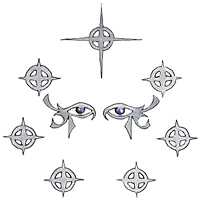Selune
SELUNE Our Lady of Silver, the Moonmaiden, the Night White Lady, She Who Guides, Elah
- Symbol: Two darkly beautiful human female eyes surrounded by a circle of seven silver stars
- Home Plane: Ysgard/Gates of the Moon
- Alignment: Chaotic Good
- Portfolio: Moon, moonlight, stars, dreams, purity, beauty, love, marriage, navigation, navigators, tracking, wanderers, seekers, diviners, good and neutral lycanthropes, autumn
- Worshippers: Selûne is worshipped by a mixed bag of followers: navigators, sailors, women, female spellcasters (especially those born under a full moon or interested in divination), good and neutral-aligned lycanthropes, those who work honestly at night, those seeking protection from Shar, the lost, the questing, and those curious about the future. Couples look to Selûne to bless them with children when they are ready, and women look to her for courage, strength, and guidance. The demands she places on her followers are few, and the goddess is reputed to be free with her gifts and boons to mortals.
- Favored Weapon: Rod of Four Moons (Mace)
- Cleric Alignment: CG, NG, CN, LG
- NWN Domain: Good, Chaos, Protection, Travel
History Relationships: Selûne’s foe was the evil goddess Shar, and she battled her ceaselessly on many planes of existence, both through mortal worshipers and servitor creatures. The undying enmity between the two goddesses predated the existence of all other Faerûnian deities. The enmity between Shar and Selune carried into their priesthoods, such that open battle often occurred when followers of each faith met.
Dogma: Selûne’s ethos seemed to be one of acceptance and tolerance over any other overriding principle. All were to be made welcome in her faith and seen as equal, and fellow Selûnites were to be aided freely as if they were one’s dearest friends. “May Selûne guide your steps in the night, and bring them to the new dawn” was the common blessing of priests of Selûne to the faithful. Novices were charged with the words of the goddess: “Let all on whom my light falls be welcome if they desire to be so. As the silver moon waxes and wanes, so too does all life. Trust in my radiance, and know that all love alive under my light shall know my blessing. Turn to the moon, and I will be your true guide.”
Day-to-Day Activities: Priests of Selûne spent their time wandering Faerûn reaching out to the faithful and to potential worshipers of the moon goddess since Selûne could be worshipped anywhere on the surface world. They made much small coin by telling fortunes because folk who tried to read the stars never achieved the same success rate in predictions as did clergy members who could call on Selûne for real guidance. Members of the Selûnite priesthood also faced lycanthropes fearlessly and thereby won respect among farmers and other members of the common folk. They were also, by the Lady’s command, generous with their healing, often charging very little beyond a meal and a warm place to sleep for straightforward healing. Selûne’s way thus made the goddess ever more popular and kept her clergy hardy, well-traveled, and in practical touch with the natural world. The Moonmaiden’s clergy were encouraged to be self-reliant, humble, and yet make as much of a success as they could in the world while always remaining as helpful and friendly to the lonely and to decent folk as possible. By this long-sighted policy, Selûne allowed her clergy to become happy, fulfilled, important people. Self-reliance and finding one’s own, practical path were more important than fussy detail in her faith, and so Selûne was also popular among eccentrics, adventurers, and mavericks of all sorts, including outcasts.
Holy Days/Important Ceremonies: Selûnite clergy embroidered their rituals into quite individual, unique observances. The basics of these were open-air dances and prayers under the moonlight with offerings of milk and wine poured upon a central altar during the nights of every full moon and new moon. These rituals were often called night stalks and during them her priests reaffirmed their closeness to the Night White Lady and communed with her when possible. The most sacred ritual of Selûne was the Mystery of the Night. The Mystery of the Night was required to be performed at least once a year by every priest.
Affiliated Orders: One long-standing knightly order of fanatic Selûnites was known as the Swords of the Lady; its members were often referred to colloquially as the Lunatics. They tended to act rapidly in response to threats from Shar and her priesthood, although their behavior was often viewed as bizarre by the public at large. Other, less fanatic knightly orders, included the Silver Path, a group of rangers, and the Guardians of Light, an elite order of paladins.
Priestly Vestments: The ceremonial dress of Selûnite priests consisted of a circlet woven of vines or flowers and white robes either of simplest white or decorated with moonstones and silver embroidery. No shoes were worn at ceremonies. The symbol of office of a high priest was a staff of wood wound about with silver and vines and flowers formed of silver and tipped with a moonstone. The symbol of Selûne was usually carved into a moonstone and incorporated into a piece of jewelry for use as a holy symbol.
Adventuring Garb: In the field, the clergy members of the Selûnite church dressed practically for the task they were undertaking. They tended to dress fashionably, but not gaudily, in day-to-day life. The preferred weapon of the clergy of Selûne was a smooth-headed mace called the moon’s hand. The moon’s hand had identical statistics to a standard footman’s mace, though it gained special combat bonuses in the hands of a specialty priest of Selûne.
